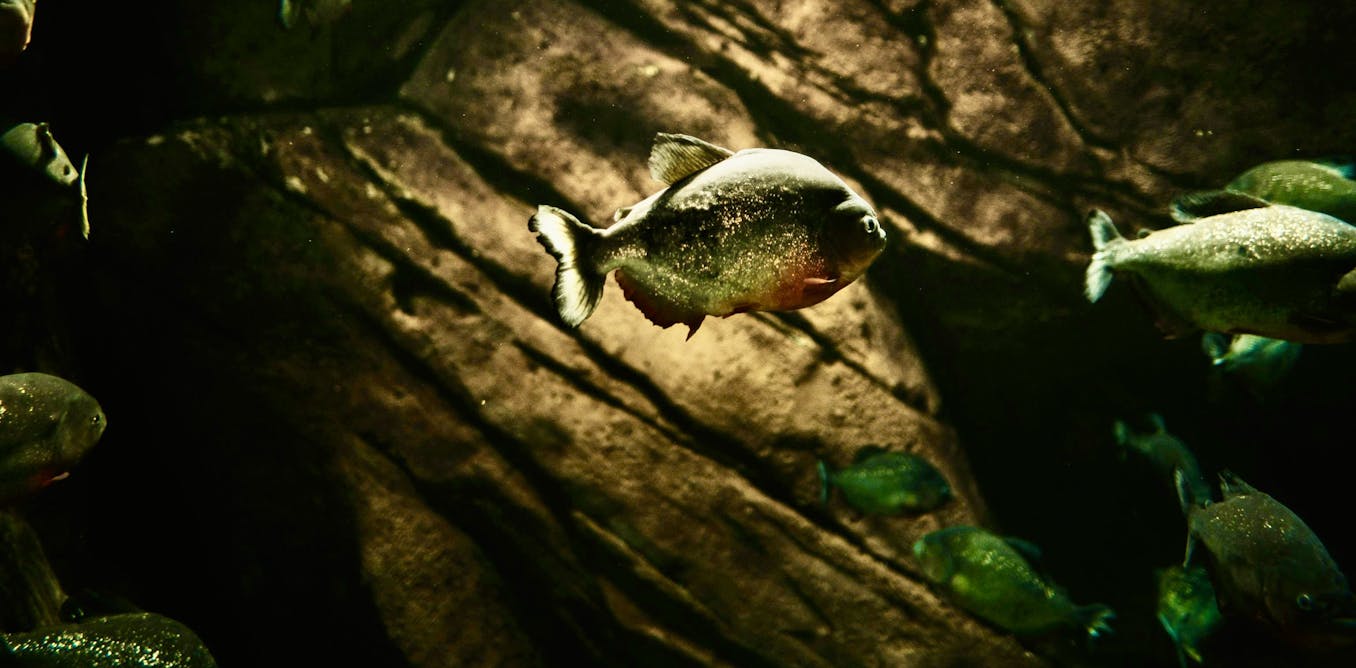Survival of the Weirdest (Full Episode) | World's Weirdest
his most bizarre survival tactics: he starts a stare-down with the enemy. The mere sight of his unwavering gaze is intimidating enough to discourage most threats.
This video, “Survival of the Weirdest,” takes viewers on a journey through the animal kingdom, showcasing some of the most extraordinary and bizarre survival strategies of different species. From the beaver’s incredible ability to construct a fortress in the frozen wilderness to the clownfish’s unique partnership with the deadly sea anemone, viewers will witness nature’s ingenuity at its finest.
The video also delves into the strange world of sea anemones, where genetic wars are waged on boulders, and lungfish defy the odds by surviving in a state of near-hibernation during droughts that can last for years.
Ultimately, “Survival of the Weirdest” highlights the remarkable adaptability and resourcefulness of the natural world. It’s a captivating exploration of the lengths to which animals will go to ensure their survival and provide valuable insight into the ingenuity of the creatures with whom we share our planet.
Watch the video by Nat Geo WILD
NARRATOR: What will you do when calamity strikes? A survival situation may be unlikely for humans, but for animals in the wild, preparing for disaster is their day job. Good planning can mean the difference between life and death. From cutting edge engineering,
To elaborate escape strategies. We’re taking notes on how these animals prepare for emergency situations, in the world’s weirdest ways. When faced with chaos, the greatest weapon, is a plan. Winter in North America. Like a scene from the end of the world. Food is scarce. And with hungry raiders on the prowl, getting caught out in the open can mean, a grisly end. But in this frozen wasteland, a fortress stands defiant.
Steam rises from its chimney. Something inside, is alive. What could have built, this emergency bunker? Just a few months before the onslaught of winter, the forest is abuzz with activity. It’s not chainsaws, but jaws at work. The American beaver.
These plant eating rodents may seem docile, but they’re about to transform their habitat, in an extraordinary animal renovation project! Phase one, collecting building material. Beavers have four iron-infused, chisel-sharp incisors that keep growing all throughout
their lives and never wear out. They can munch their way through a small tree, six inches thick, in a matter of minutes. Next, they’ll need to transport the wood to the construction site, but no trucks or cranes here.
Beavers use canal highways to float their cargo home. Their paddle tails and duck-like feet can propel them through water at up to five miles an hour! And now, they execute phase two of their bunker project; the beaver dam.
The trickling sound of leaking water triggers one of the beaver’s strongest instincts. Build, build, build! This creates a large defensive moat, in which they construct the final phase: the beaver lodge. They pile up rocks, branches and logs as high as six feet
above the water, and weather seal the structure with mud. They’ll need to work fast: autumn is about to end. But the best laid plans, can attract unwanted attention. The beavers have been stocking up twigs and branches underwater. Food to last through winter.
And this hulking moose is just reaping all the benefits. No plan and no permission. But how do you stop someone almost 30 times your body weight? The beaver’s paddle tail makes a loud splash. A stern warning, and also an alarm call for other beavers.
Size doesn’t matter, when you’ve got attitude. The beaver lodge is complete, in time for the late November snow. This astonishing structure is more than just a shelter, it’s got secure underwater entrances, multiple rooms, and even a ventilation shaft.
And now that the mud walls have frozen solid, this bunker is virtually impenetrable. These little emergency planners may have created the safest place to ride out the winter armageddon. It’s certainly not easy to build a survival hideout from scratch,
so what if you didn’t need to? The warm waters of the indo-pacific. This is an unforgiving fish-eat-fish world. Apex predators are on patrol, and deadly traps are ready to spring. If you’re a small fish in this big pond,
it’s probably going to end in teeth. These colorful clownfish, however, have discovered an unusual place to bunker down; among the stinging tentacles of a sea anemone. There are over 1,000 species of sea anemone in the ocean.
But don’t be fooled, they are nothing like the innocent flowers they’re named after. Sea anemones are meat-eating killer fish traps! With the slightest touch, it injects a venomous neurotoxin into its prey, strong enough to paralyze a small fish.
The tentacles drag the helpless fish into its central mouth, where it’s digested whole! They may be clownfish, but they’re no clowns. Sheltering in the arms of a predator takes a special kind of preparation. Scientists believe that clownfish brush themselves
carefully against the tentacles, until a layer of anemone mucous covers the fish. This fools the anemone into accepting it. Clownfish aren’t the only ones to befriend this killer. Smaller sea anemones are a hot commodity in the field of underwater security.
As part of the hermit crab’s bizarre survival plan, it gathers up sea anemones to use as bodyguards. Hermit crabs don’t have armor of their own, so they hide out in shells discarded by other animals. And this one’s got a sea anemone, pre-installed!
But one isn’t always enough. Sea anemones like staying put. They grip on to hard surfaces with a large disc-like foot. This hermit crab knows just the trick. A slight tickle here, an easy lift. His moves are so smooth that the anemone doesn’t even close
up during the procedure. An octopus has spotted his prey. He pounces on the crab, but gets a mouthful of anemone. He tries again. The meal is striking back. It’s not worth his trouble. And the hermit crab’s mobile fortress is a stinging success.
NARRATOR: You may have think you’ve seen weird, but things get even weirder when sea anemones go to war, with each other. That’s because two families struggle to share a single boulder. The science of genetics has taught us that the need to
protect and spread DNA is a basic driver of animal behavior. The aggregating sea anemone of the Pacific U.S. coast has taken that to extremes. It can reproduce sexually by releasing sperm and eggs into the sea to drift and mingle.
But weirdly they also multiply by cloning themselves; splitting in half like dividing cells. Through cloning they can rapidly colonize every nearby space with genetically identical copies of themselves. The more crowded their living conditions the better they are able to withstand the constant daily drought they face during low tide.
And by cloning each anemone, they ensure that its territory is dominated only by its own DNA. Until two growing colonies of assembled anemones come tentacle to tentacle. The two colonies are the same species but carry different DNA.
They’re in a permanent war of attrition for possession of this boulder. The anemone clones on the front lines of this war have developed stinging clubs, which they use to fight off the advancing enemy anemone.
The warrior clones on the battlefront can die from repeated strikes. Or do they? Each animal in this army is genetically the same animal, so weirdly; they can die, yet still live on in others. So the clone war goes on.
Lungfish are an ancient fish that can be found in Africa, South America and Australia. They live in the murky margins of swamps and rivers. But sometimes, water can dry up during droughts. Lungfish have found a way around this fundamental problem.
Their strange mutation has enabled them to survive for more than 300 million years. When their watery home vanishes; lungfish turn to breathing air like a mammal. Droughts can last for years on end.
So the lungfish digs down in mud to create a burrow. Where it coats itself in mucous, which dries to a leathery body-bag, protecting it from total dehydration. The lungfish then shuts its system down and waits.
It can survive for years if that’s what it takes. The lake and the fish may be long forgotten, but the lungfish will still be there. Its metabolic rate drops by 60%. What little energy it does need,
comes from slowly consuming its own muscles. It effectively eats itself to survive. When the drought breaking deluge finally comes, the lungfish awakens from its dormant state, re-animated and ready to roll. On an evolutionary scale, this was a game changer,
that’s kept the lungfish alive since before dinosaurs. Some weird animals have developed battle plans that can defeat the enemy, without even touching them. The dry, red earth of Africa’s Kalahari desert. Meerkats have banded together in a tribal community.
While the mob turns up the dirt in search of breakfast, one adult takes on the critical role, of sentry. He stands upright on the highest lookout for over an hour at a time, where he can spot predators from more than half a mile away.
His persistent call reassures the gang that the coast is clear. But at the first sign of danger, he uses one of 30 distinct messages to warn his family of the threat. This time, it’s a cape cobra. Among the most dangerous snakes in Africa. With venom so potent, it could kill a grown man in 30 minutes. Many creatures would run from this deadly adversary. But not the meerkats, they stand their ground.
They’ve got a plan. For the meerkats, the best fight, is no fight at all. They dart their heads back and forth, spit and growl menacingly. It’s an elaborate intimidation display, a bluff to discourage the snake. But there’s more to this plan.
Multiple moving targets can confuse the predator. The snake has difficulty singling out and attacking its prey. It’s all too much for the cape cobra, and it makes a tactical retreat. The meerkat mafia have made an offer it can’t refuse.
You mess with one, you mess with all of the family. NARRATOR: We’ve seen the most amazing defenses: playing dress-up, playing house, playing offense. But this weaverbird has a different kind of defense strategy to avoid predators: an excellent home security system.
Of course, as with any good real estate, it’s all about location. He’s found an acacia tree with everything a potential mate could want; a water view, shade, and most importantly, viciously sharp thorns to keep most predators away.
The custom built home doesn’t hurt either. Male weavers build intricate, tightly woven nests. If the female is happy with her general contractor’s design, she moves in. Weavers depend upon their construction skills to keep their hatchlings safe. Usually, it works.
But it doesn’t stop the predators from trying. The noisy, boisterous colony is attracting some unwanted attention. This snake wants eggs for breakfast. As it carefully winds its way around the thorns towards a nest, a weaver sounds the burglar alarm. With a few deft moves, the weaver dumps his nemesis into the drink. Fending off this attacker won’t be so easy. The gabar goshawk can perch right on the nest. Actually breaking into it is a little harder.
But all it takes is one little design flaw and the hatchlings are toast. Even with all their precautions, for the weavers, this is still a pretty dangerous neighborhood. The weaver bird’s weird look out call takes the passive approach to survival.
But when your enemy is mother nature herself, the best defense of all is to get out of town. Deep in the amazon rainforest, the ground is ablaze with the tiny terror, of the fire ant. A torrent of soldiers!
Armed to the teeth with a burning bite, they strip animals to the bone. Its sting contains cell-destroying venom that wreaks havoc on even human flesh. This flaming horde of ants seems unstoppable. But when the rainy season comes,
the amazon brings out nature’s extinguisher: an epic flood of biblical proportions! Over 100,000 square miles of forest submerged under some 40 feet of water. The end is surely nigh. But not even water can douse this ingenious inferno! The ants join together.
Their bodies combine to form an incredible, floating ark! They trap tiny bubbles of air around themselves to increase their buoyancy. This miraculous raft can stay afloat for months on end. But the journey is fraught with peril.
Their most precious cargo is the colony’s queen. Their future depends on her survival, so she stays dry, literally trampling on her royal subjects. The lower peasants are picked off one by one, like floating clumps of fish food. Some will drown.
But she’s a queen to die for! Finally, landfall. The ants haul ‘her highness’ to safety. The dynasty has found salvation on their self-made ark. And now they return to what they do best: spreading their wildfire. Even against a catastrophic emergency,
the fire ants blaze on. Getting a move on is a well-known survival strategy. For mother turtles, her journey is all about going home. She often gets credit for being a good mother. But really, she’s just a good navigator.
Seven different species roam the world’s oceans. When it’s time to have babies, mothers are famous for finding their way back to the exact place they were born. One turtle with a satellite tag was recorded making a journey of over 12,000 miles.
That kind of painstaking precision is only for getting to the beach. Once they arrive, it’s chaos: a fin- flapping, sand-kicking free for all. This mother green turtle may dig several nests and lay multiple clutches of eggs over a season.
She can navigate the globe. But can’t quite remember where she dug her last nest. The eggs she accidentally digs up tonight could even be the ones she laid last month. The morning sun bakes them to a crisp. As the season wears on,
mother turtles continue to arrive. Eggs begin to hatch even as mothers are still nesting. Once again, mom doesn’t seem to notice or care. These babies she’s steamrolling could very well be hers. Not her problem.
She just wants to add another 100 eggs to the season total. Throughout the world, all sea turtle mothers leave their babies to fend for themselves. The little ones have to make a mad dash to the sea, across a killing field.
No parental protection, and every predator on the beach gunning for them. Their chances are one in 1,000. Any baby that survives the ordeal remains easy prey for ocean predators. It won’t reach breeding age for another ten years.
Sure she’s not the cuddliest mother but playing the numbers game isn’t a bad bet. She could produce thousands of young in her lifetime. If more than two of those survive long enough to breed, that’s called winning. NARRATOR: Our next weird creature is the envy of
pregnant women everywhere. The giant sea horse is neither gigantic nor a horse. Instead, it’s a foot-long fish that lives in the Pacific Ocean. But its name isn’t nearly as mixed up as the way it reproduces. It starts off simple.
Boy meets girl, a brief courtship, tails intertwine. The newly minted couple will stay together throughout the breeding season. About that breeding, the female makes the eggs. But instead of growing them inside her, or depositing them on the ocean floor like most fish,
she deposits them in the guy. A specialized pouch in his belly opens up to receive the eggs. She floats away. He fertilizes the eggs and takes over the heavy-duty work of incubating their offspring over the next few weeks.
Why does the male eat for several hundred? Reproduction is energy intensive. By sharing the baby burden, it gives the female a chance to invest her energy in laying the next round of eggs. More eggs means more chances some offspring will survive.
The father finds out the hard way when the young are ready to emerge. He experiences a set of intense contractions. No lamaze classes for this guy. He just suffers through it. And up to 400 children wriggle free and swim away.
And he looks for his mate to start the painful process over again. That’s just mixed up. Parenting styles are as varied as in the human world. You’ve got tiger moms, helicopter dads, the free-rangers, and worry warts.
But when the only rule children have to obey is survival of the fittest, there are bound to be problems. A pair of snowy egrets makes a handsome young couple. They’re graceful, and elegantly dressed. But this picture-perfect family hides a dirty little secret.
A murder is about to be committed, and nobody’s ruffling a feather over it. Snowy egrets inhabit the waterways of the US, Central and South America. This pair in Florida have three little hatchlings. They share the work of raising them.
Taking turns, stalking the shallow salt marsh, spearing small fish and crustaceans, and shuttling food back to the nest. There’s one thing that doesn’t seem to concern them: it’s what the kids are up to at home.
The two oldest chicks are getting stronger and more aggressive. While the youngest only gets weaker. At first the older chicks just shove it out of the way. But then they begin to stab and beat their younger sibling. Mom’s right there. Does she intervene? No, she turns a blind eye. As far as these parents are concerned three chicks is more than they can feed this year. So they let the kids settle it themselves. The parents may not care,
but at least there’s one bystander who does. The evidence is quickly erased. Mom and dad keep up appearances like nothing happened. A little family murder is swept under the rug. Bizarre behavior can strike some of the world’s most
Famous mothers and fathers; Antarctica’s emperor penguins. Their dedication to their young is legendary. Almost immediately after laying the egg, mother penguins march to the sea on a food run. While fathers endure the coldest winter on earth, incubating the pair’s precious egg until it hatches.
It’s a brutal three months, taking a toll on eggs and new-borns alike. Mothers return with bellies full of fish for their young. Unfortunately, they’re also carrying a recipe for madness. Their blood is coursing with prolactin; a powerful hormone that stimulates parental behavior
in both males and females. Most mothers reunite with their mate and instantly bond with a chick they’ve never seen before. But for those whose chicks have died, there’s no reunion. Her parental hormones are still raging.
She searches the mob for a chick to nurture. Any chick. Even if it means kidnapping. The real parents fight to keep control of their baby. In the melee a chick can be crushed, sometimes by its own mother and father.
Occasionally the imposters win the battle. But the chick’s unfamiliar call doesn’t trigger their instinct to feed it. Once their madness passes, they lose interest. Leaving the chick hungry and alone. Where temperatures hover at 20 below zero,
injured chicks don’t survive long. Nature’s weirdest ironic twist proves that you can have too much of a good thing. Even the most positive parental urges can have a sinister side. NARRATOR: The survival of the weird just got weirder. Meet the thresher shark.
It may be one of the most recognizable fish in the ocean. The long tail propels it forward in perpetual motion. Sharks like the thresher are one of just a few kinds of animal that never come to a stop.
They are ram ventilators, meaning they can only breathe as long as they are moving forward, and water is flushing past their gills. For the thresher, to stop is to die. But the thresher shark’s enormously long whip-like tail
Is also put to work in the world’s weirdest shark attack. This small-mouthed, small toothed shark hunts mostly small schooling fish. The shark’s long tail provides the speed and maneuverability necessary to chase these fish. When the thresher can find a tightly packed school,
it uses an extremely rare hunting technique, unique among sharks. It drives forward and down flipping its tail over its head, and cracking it like a whip. The tip of the thresher’s tail has been measured moving at almost 50 miles an hour.
It strikes with enough energy that several fish at a time can be taken out with its high-speed tail slap. The thresher’s tail generates enough force to propel the shark right out of the water if necessary.
For small sharks and fish, surviving a close call with an angel shark is a rare event. Angel sharks have fallen so far from the shark family tree that they are virtually subterranean in lifestyle. But they may be the premier ambush hunters of the shark world.
Unusual in sharks, the angel appears to be largely a visual hunter, but one with weird and extreme capabilities. Angel sharks will settle to the bottom and gently bury themselves. Setting a trap of impressive proportions.
They may wait days in this position for prey to pass overhead. Then this booby-trap of a shark erupts from the sand, and strikes! In just a tenth of a second it can arch its body upward in a lightning fast attack.
They’ve been seen charging at anything that passes by. They may spit the food out afterwards if they don’t want it. A shark that has to wait for prey to pass overhead can’t afford to be picky.
The darkness of night isn’t an obstacle for this shark’s hair-trigger hunting style. But in a weird twist, it can’t see in the dark like many night hunters can. Instead, the angel shark’s eyes appear to have evolved to detect the faint glow of bioluminescent plankton that
will light up in the wake of a passing fish. A rare example of indirect detection. The angel shark can’t see its prey at night, but it can detect the microscopic animals that detect its prey.
The angel shark’s abilities are a stunning example of what hundreds of millions of years of trial and error can do. NARRATOR: These are the survivalists of the wild. Preparing for the most extreme circumstances in the world’s weirdest ways. Ready to hide, ready to fight. And in a losing battle, ready with an exit plan.
The North American bobcat is a hunter with a wide range of tastes. It’s looking for an easy meal and has this harmless hognose snake in its sights, but this little snake knows how to act like it’s dangerous; hissing, and flaring like a cobra’s hood. Seeming to be big and bad, often works. But bobcats aren’t easily fooled. The snake’s problem just got bigger, so the hognose must dig deeper into its bag of tricks. With high drama, it plays dead.
It even exudes a rotting smell to kill the bobcat’s curiosity. Great hunters like the bobcat prefer fresh meat, and little appetite for a dish of stinking dead snake. The snake knows this and gives the performance of its life.
When the bobcat gives up and goes in search of a better meal, the little mutant’s problem is solved. It takes a bow, and exits stage left. The markets of Jaipur, India are under constant threat from bandits, waiting for an unsuspecting target.
This gang of langur monkeys is devious, relentless and worst of all, untouchable. Monkeys are symbols of the Hindu gods. Harming them is a religious offense. The most the fruit seller can do is shoo them away.
The monkey’s biggest threat comes from each other. They form rival gangs, roaming the streets and fighting turf wars over access to the ample supply of food. As India becomes more urbanized, expect more monkey mafias. An unstoppable menace.
But one that can be weirdly cute. Autumn leaves are already starting to fall, and with them, the last morsels of food. Now is the time for grey squirrels to put their emergency plan into action, storing away protein-rich nuts for winter.
It seems like an innocent activity, but what’s astonishing about these hoarders, is their devious, tactical mind. They’re well versed in the art of espionage. It’s the acorn cold war. A stealthy spy watches from above,
waiting for a squirrel to reveal her nut hiding spot so he can steal it for himself. But he’s been busted. The squirrel on the ground knows she’s being watched. And she puts on a show. She digs a hole, as usual, but,
With a little sleight of hand, she escapes without burying anything. The spy swoops in, and he’s been duped. The nut has already been squirreled away to another, more secret location. It’s hard enough to keep track of hundreds of buried nuts.
Much harder when nature covers it all in white. But the squirrel is a master of mental gymnastics. It remembers landmarks, like trees and buildings, and triangulates a mental map of its hidden stashes. It’s believed that squirrels can locate a nut up to nine
months after it was buried! With not only phenomenal memory, but the ability to deceive, the remarkable grey squirrel is a forward thinker, with a license to live. Captioned by Cotter Captioning Services.
About Nat Geo WILD
National Geographic Wild is a place for all things animals and for animal-lovers alike. Take a journey through the animal kingdom with us and discover things you never knew before, or rediscover your favorite animals!
Video “Survival of the Weirdest (Full Episode) | World's Weirdest” was uploaded on 06/15/2021 to Youtube Channel Nat Geo WILD





































